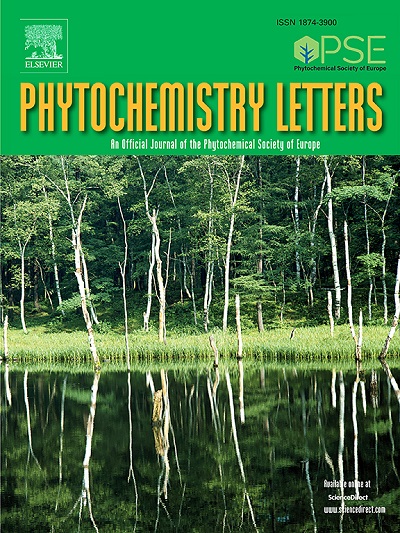天然产物代谢组学研究中生物活性预测验证的重要性:以大麻(Cannabis sativa)抗菌特性为例
IF 1.4
4区 生物学
Q4 CHEMISTRY, MEDICINAL
引用次数: 0
摘要
信息学引导的方法包括非靶向质谱代谢组学来预测天然产物混合物中的活性化合物已经变得越来越普遍。有了这样的策略,有时可以在分馏过程的早期针对活性化合物进行分离,从而减少工作量并提高成功率。然而,这种方法需要后续研究来解决假相关性的潜在问题。为了证明这一点,我们采用植物大麻(大麻)作为测试案例。采用肉汤微量稀释法测定了苜蓿提取物对耐甲氧西林金黄色葡萄球菌(MRSA)的抑制作用。利用Orbitrap质谱联用高效液相色谱法和高分辨质谱法对提取液和提取物的代谢组学数据进行采集,并采用选择性比分析作为统计工具对两轮提取液的活性化合物进行预测。从分离早期,我们就预测大麻二酚(1,CBD)和大麻二酸(2,CBDA)是主要的活性成分。这些预测,当验证了后续的最低抑制浓度(MIC)测定纯化合物,证明是准确的。然而,在使用相同统计方法的后期分离中,先前报道的苜蓿成分n -反式-对- coumaroyylyramine (3, pCT)和n -反式阿铁酰乙胺(4,FT)被预测为活性的原因。对这些纯化合物的后续分析表明,它们对MRSA没有直接或协同的抗菌活性。本研究强调了非靶向代谢组学研究中活性化合物的统计预测是如何内在相关的,并强调需要后续研究来验证这种预测的准确性。本文章由计算机程序翻译,如有差异,请以英文原文为准。
The importance of verifying biological activity predictions in metabolomics studies of natural products: A case study on antimicrobial properties of Cannabis sativa (hemp)
Informatics-guided approaches involving untargeted mass spectrometry metabolomics to predict active compounds in natural products mixtures have become increasingly common. With such strategies, it is sometimes possible to target active compounds for isolation early in the fractionation process, thereby reducing effort and increasing hit rate success. However, such approaches require follow up studies to address the potential problem of false correlations. To demonstrate this, we employed the botanical Cannabis sativa (hemp) as a test case. A C. sativa extract was fractionated in several stages, and the ability of the fractions to inhibit the growth of Methicillin-resistant Staphylococcus aureus (MRSA) was evaluated in broth microdilution assays. Metabolomics data were collected for the extract and fractions using high performance liquid chromatography coupled to high resolution mass spectrometry on an Orbitrap mass spectrometer, and selectivity ratio analysis was employed as a statistical tool to predict the active compound from two different rounds of fractionation of the C. sativa extract. From the early stage of fractionation, we predicted that the cannabinoids cannabidiol (1, CBD) and cannabidiolic acid (2, CBDA) were major active constituents. These predictions, when verified with follow up minimum inhibitory concentration (MIC) assays of the pure compounds, proved to be accurate. However, in a later stage of fractionation using the same statistical approach, the previously reported C. sativa constituents N-trans-p-coumaroyltyramine (3, pCT) and N-trans-feruloyltyramine (4, FT) were predicted to be responsible for activity. Follow up assays with these pure compounds revealed that they possess no direct or synergistic antimicrobial activity against MRSA. This study highlights how statistical predictions of active compounds in untargeted metabolomics studies are inherently correlative and emphasizes the need for follow up studies to verify the accuracy of such predictions.
求助全文
通过发布文献求助,成功后即可免费获取论文全文。
去求助
来源期刊

Phytochemistry Letters
生物-生化与分子生物学
CiteScore
3.00
自引率
11.80%
发文量
190
审稿时长
34 days
期刊介绍:
Phytochemistry Letters invites rapid communications on all aspects of natural product research including:
• Structural elucidation of natural products
• Analytical evaluation of herbal medicines
• Clinical efficacy, safety and pharmacovigilance of herbal medicines
• Natural product biosynthesis
• Natural product synthesis and chemical modification
• Natural product metabolism
• Chemical ecology
• Biotechnology
• Bioassay-guided isolation
• Pharmacognosy
• Pharmacology of natural products
• Metabolomics
• Ethnobotany and traditional usage
• Genetics of natural products
Manuscripts that detail the isolation of just one new compound are not substantial enough to be sent out of review and are out of scope. Furthermore, where pharmacology has been performed on one new compound to increase the amount of novel data, the pharmacology must be substantial and/or related to the medicinal use of the producing organism.
 求助内容:
求助内容: 应助结果提醒方式:
应助结果提醒方式:


